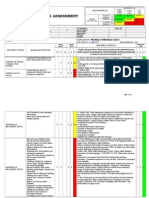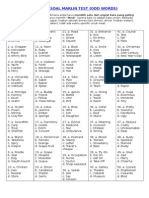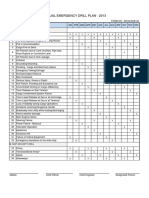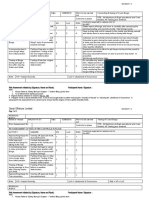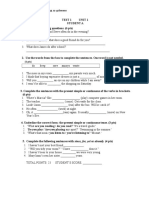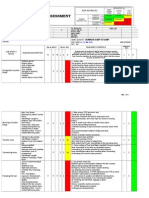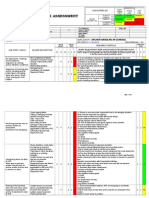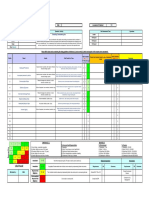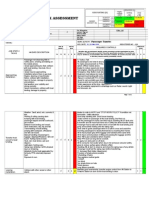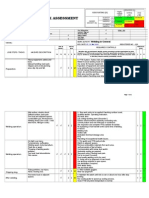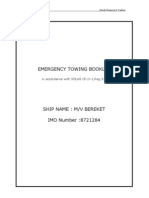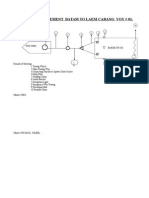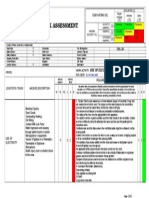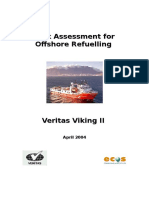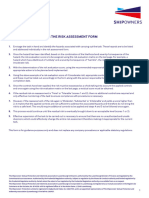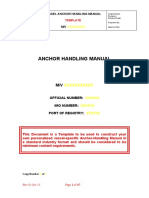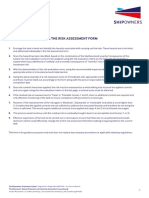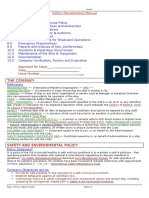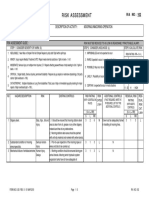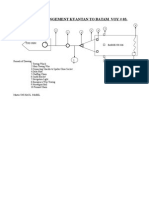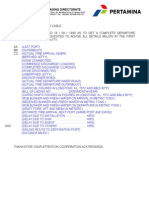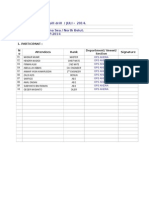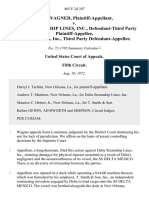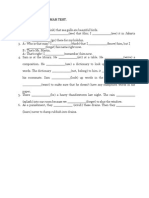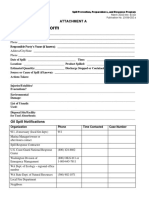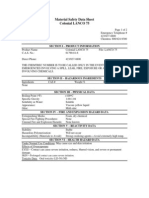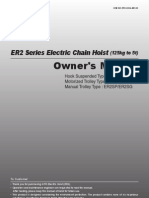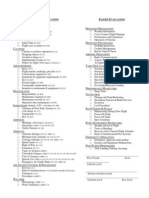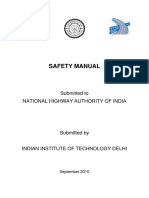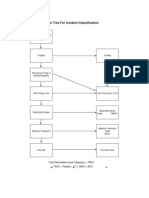Risk Assessment No. 02 ANCHOR HANDLING, RETREVING CRUCIFIX B
Risk Assessment No. 02 ANCHOR HANDLING, RETREVING CRUCIFIX B
Uploaded by
Devi Ratna PratiwiCopyright:
Available Formats
Risk Assessment No. 02 ANCHOR HANDLING, RETREVING CRUCIFIX B
Risk Assessment No. 02 ANCHOR HANDLING, RETREVING CRUCIFIX B
Uploaded by
Devi Ratna PratiwiOriginal Title
Copyright
Available Formats
Share this document
Did you find this document useful?
Is this content inappropriate?
Copyright:
Available Formats
Risk Assessment No. 02 ANCHOR HANDLING, RETREVING CRUCIFIX B
Risk Assessment No. 02 ANCHOR HANDLING, RETREVING CRUCIFIX B
Uploaded by
Devi Ratna PratiwiCopyright:
Available Formats
.
RISK ASSESSMENT
PT. SWIBER BERJAYA
CHECK PPE & CONTROLS REQUIRED
Hard Hats
Safety Shoes
Safety Glasses
Hearing Protection
Cotton Gloves
Leather Gloves
Respirator
Work Vest
Safety Harness
Face Shield
Goggles
Ventilation
Fire Extinguisher
Lockout / Tag-out
Permit to Work
Stokes Basket
Life Rings
Barricades
WORK ACTIVITY:
VESSEL:
AHT run over buoy, propeller
fouled; damage to property.
Man overboard due to
slippery deck or lost balance
when throwing the buoy
catcher.
Slip, trip and fall on deck due
to slippery deck or rolling
vessel; injury to crew.
Metabolic (body) heat
aggravated by full body PPE;
externally imposed heat.
Exposure to sun.
*S
*E
REGISTERED NO :- 002
INITIAL
RISK
REQUIRED CONTROLS
Describe fully all equipment, facility, and/or procedure controls applicable for each
hazard (i.e. if PPE is used as control, it must be specifically describe.) If a control can
only be verified by documentation then it must be available. All controls must be valid
in that they reduce severity, probability of both.
S: Conduct Toolbox talk prior to work.
Test engines, bow thruster and other work related equipment.
Main deck to be made clean and tidy before operations.
Exercise good seamanship to manoeuvre vessel clear of buoy.
Maintain communication between bridge and deck crew.
Station look out at stern to report distance if required.
Crew in full PPE + work vest until completion of anchor handling.
Steel deck must be painted with non-skip paint.
Crew to have good footing & well balanced prior to throwing out the buoy
catcher, use safety line if weather not favourable.
Crew throwing the catcher must synchronize their movement.
Crew stay clear of stern once the buoy hooked by the catcher.
H: Increased fluid intake (Awareness)
Provision of shade where possible
Scheduling of tasks
Ship captains medical guide
COSWP.
Sun block
Sun shade brims on hats
Tinted glasses
Long sleeve coveralls.
HAZARD DESCRIPTION
*H
Catching anchor buoy
from the sea.
Anchor Handling. Recovering anchor, crucifix buoy.
REV. DATE: 02 / 20 Mar 2009
Risk to
WHAT?
JOB STEPS / TASKS
Other - List
RESIDUAL
RISK
Page 1 of 5
Heaving buoy onto deck.
Disconnect buoy on deck
Shifting buoy to the crash
rail to clear deck for
working.
If tugger instead of work wire
is used, tugger wire or buoy
catcher on tension may
parted; injury to crew.
Injury to crew due to sudden
movement of buoy.
Marine growth on buoy can
cause cuts or abrasions on
crew body/limbs.
Back pain when lifting heavy
shackles.
Trap fingers, hand or feet
when making up or undoing
shackles pin.
Shark Jaw or wire socket
failure; injury to crew.
Metabolic (body) heat
aggravated by full body PPE;
externally imposed heat.
Exposure to sun.
Parting of tugger wire being
used to shift buoy.
Injury to crew due to rolling
buoy on deck caused by
sudden movement of AHT.
Metabolic (body) heat
aggravated by full body PPE;
externally imposed heat.
Exposure to sun.
S: Tugger wire and buoy catcher must have certificate and tugger
operated by experienced crew. All crew stay clear of aft deck.
Master manoeuvre vessel to ease tension on the tugger or buoy catcher
wires.
S: Exercise good seamanship to manoeuvre AHT to reduce roll, pitch and
strain on pennant wire.
Buoy to be secured off with wedges/chocks.
Stay clear of buoy rolling direction.
Crew to avoid too close to buoy or picking marine growth.
Use correct manual lifting technique.
Use pulling hooks to dislodge shackles pin.
Crew to assist each other each other to handle heavy loads.
Crow bar used to turn shackle and person using it must steady himself on
good footing to ensure he and the crow bar will not slip.
Raise cable/wire lifter to lift socket to suitable height so that crew can
disconnect shackles from wire socket.
Do not stay in the wires line of fire.
H: Increased fluid intake (Awareness)
Provision of shade where possible
Scheduling of tasks
Ship captains medical guide
COSWP.
Sun block
Sun shade brims on hats
Tinted glasses
Long sleeve coveralls.
S: All crew to stay clear from aft deck when pulling the buoy.
Condition of tugger wire must be inspected prior to using it.
Use wedge/chock to stop buoy from rolling.
Lashing of buoy as soon as buoy reached crash rail.
Master to manoeuvre AHT to reduce rolling and pitching.
H: Increased fluid intake (Awareness)
Provision of shade where possible
Scheduling of tasks
Ship captains medical guide
COSWP.
Sun block
Sun shade brims on hats
Tinted glasses
Long sleeve coveralls.
Page 2 of 5
Connecting work wire to
anchor pennant.
Breaking loose the anchor
off bottom and heaving up
to stern roller or onto
deck.
Sudden jerk on pennant wire
due to vessel movement;
injury to crew.
Back pain when lifting heavy
shackles.
Trapped fingers between
shackle and pin or wire.
Shark Jaw or wire sockets
failure; injury to crew.
Metabolic (body) heat
aggravated by full body PPE;
externally imposed heat.
Exposure to sun.
Parting of tensioned pennant
wire and lateral/sweeping
movement of pennant wire.
Injury to deck crew.
Anchor sliding side to side on
deck, damage to vessel.
Decking anchor.
Disconnecting anchor (if
required.)
Sudden jerk on anchor wire
due to vessel movement.
Shark Jaw or wire socket
failure; Injury to crew.
Back pain.
Trapped finger/hand/feet
causing injury to crew.
S: Master manoeuvre vessel to ensure pennant wire resting on Shark
Jaw with no strain.
Maintain communication bridge-deck to ensure safe operations.
Use correct manual lifting technique.
Use pulling hook to pull heavy shackle, etc.
Crew to assist each other to handle heavy objects.
Crow bar used to turn shackle and person using it must steady himself on
good footing to ensure he and the crow bar will not slip.
Raise cable/wire lifter to lift socket to suitable height so that crew can
disconnect shackles from wire socket.
Do not stay in the wires line of fire.
H: Increased fluid intake (Awareness)
Provision of shade where possible
Scheduling of tasks
Ship captains medical guide
COSWP.
Sun block
Sun shade brims on hats
Tinted glasses
Long sleeve coveralls.
S: Crew to stay clear of aft deck.
Manoeuvre vessel to keep pennant wire in the middle of stern roller and
avoid jerking of pennant wire.
Guide/Tow Pins used to advantage to stop wire sweeping movement and
to align pennant wire to work winch.
Adhere to Anchor Handling Procedure.
S: Maintain tension on wire and manoeuvre vessel to keep stern inline
with the anchor wire direction.
Raise tow pin and shark jaw as soon as anchor past the equipment.
Crew to keep clear of aft deck until instructed by Master/CO
Anchor to be choked or lashed if necessary.
S: Master manoeuvre vessel to ensure anchor wire is kept slack.
Anchor wire socket resting on Shark Jaw with no strain.
Maintain communication between bridge, deck and barge/rig to ensure
safe operations.
Stay clear of wires line of fire.
Use correct manual lifting technique.
Use pulling hooks.
Crew to assist each other to handle heavy objects.
Crow bar used to turn shackle and person using it must steady himself on
good footing to ensure he and the crow bar will not slip.
Raise cable/wire lifter to lift socket to suitable height so that crew can
disconnect shackles from wire socket.
Page 3 of 5
Recovering of anchor wire
by barge/rig.
Shifting anchor to stern
roller
of AHT.
Passing anchor from stern
roller to anchor rack of
barge/rig.
Disconnect pennant wire
from work wire.
Passing pennant wire
socket end to barge/rig.
Parting of tensioned anchor
wire; human injury.
Lateral/sweeping movement
of anchor wire across the
stern; damage to property.
Anchor wire crossing pipeline
causes chafing on the
pipeline; damage to property.
Parting of tension pennant wire causing injury to crew.
Parting of tensioned pennant
causing anchor to drop onto
pipeline or power cable;
gas/oil leak, fire/explosion,
pollution.
Human injury/fatality.
Anchor sliding side to side
causing damage to ships
stern structure.
Lateral/sweeping movement
of pennant wire across stern.
Parting of tension pennant
wire while transferring anchor
Accidental dropping of anchor
and hit pipeline; gas/oil leak,
fire/explosion, pollution.
Human injury/fatality.
AHT collision with barge/rig;
damage to property.
Sudden tension on work wire
due to movement of vessel
may cause: injury to crew,
damage to anchor rack,
parting of pennant wire.
Heavy wire and shackle may
cause back pain to crew.
Trapped fingers, hand or feet.
Shark Jaw or wire socket
failure.
Swinging crane
block/headache ball &
overhead load may strike
crew or ship structure.
Crane rigging failure.
S: Maintain communication with barge foreman to coordinate backing up
or applying some tension on the wire while being winched in by barge/rig.
Crew to stay clear of aft deck.
Guide/Tow Pin kept raised to hold wire in position.
Master to manoeuvre vessel to keep stern in line with the anchor wire fair
lead & Maintain a slight tension on the wire to avoid wire touching bottom.
Latest TOPO chart with current anchor pattern available for reference.
Colour marking of pipe line on the survey equipment screen if possible.
S: Maintain good communication with barge/rig and deck.
Coordinate winch slacking with vessel manoeuvre.
Never shift anchor at position less than 100 meters from pipeline/cable.
Never leave anchor over stern roller when crossing pipeline/cable.
Master manoeuvre vessel to ensure AHT stern is in line with barge/rig
wire fair lead while lowering.
S: Crew to stay clear of open aft deck.
Towing pin kept raised to control wire movement.
Master to manoeuvre AHT to line up stern towards anchor rack for
passing the anchor.
Maintain communication with barge/rig foreman to coordinate anchor
transfer.
Good seamanship to maintain vessel in good distance from anchor rack.
Winch slacking of wire pennant in coordination with heaving of anchor
winch.
AHT to stand off at safe distance taking into consideration wind, swell and
currents.
S: Crew stay clear until pennant wire socket resting on Shark Jaw.
Master to manoeuvre vessel to keep station and pennant wire has no
tension.
Post look out at stern behind crash bar to report distance from barge/rig.
Use correct manual lifting technique. Use pulling hook.
Crew to assist each other to handle heavy objects.
Crow bar used to turn shackle and person using it must steady himself on
good footing to ensure he and the crow bar will not slip.
Raise cable/wire lifter to lift socket to suitable height so that crew can
disconnect shackles from wire socket.
S: Crane cargo block/Headache ball must have hooks sling extension.
Tag line available to steady/control load and crew to stay away from
hooks swing direction.
Crew to stay clear of overhead/suspended load.
Banksman to give good/correct signal to crane operator.
Page 4 of 5
(If anchor was
disconnected)
Passing anchor from AHT
deck to barge/rig by crane.
Passing of buoy to
barge/rig.
Unspooling pennant wire
from work drum,
disconnecting from work
wire.
Shifting buoy, anchor and
pennant wire to stow
position & lashing.
Swinging crane
block/headache ball &
overhead load may strike
crew or ship structure.
Crane rigging failure.
Parting slings causing anchor
to drop on AHT.
Damage to property.
Fire, Pollution & Injury to
crew.
Slip, trip and fall.
Hit by swinging anchor.
Finger trapped between
crane hook and sling.
Marine growth cuts.
Back pain injury.
Hand or finger injury due to
broken wires/splinters.
Hit by springing action of
coiled wire.
Buoy rolling.
Tugger wire parting.
Injury to crew.
S: Crane cargo block/Headache ball must have hooks sling extension.
Tag line available to steady/control load and crew to stay away from
hooks swing direction.
Crew to stay clear of overhead/suspended load.
Banksman to give good/correct signal to crane operator.
As soon as anchor lifted from deck, crane operator must swing anchor
away from ship.
Crew to stay away from direction of hanging anchor swing.
Crew to watch for their own position when trying to steady the lifted
anchor.
When hooking slings, two crew need to do it.
Master to bring vessel away from barge/rig if anchor already lifted clear
of crash rail level.
S: Crew in full PPE including good leather gloves.
Use correct manual lifting technique.
Use pulling hooks.
Crew to assist each other to handle heavy objects.
H Crow bar used to turn shackle and person using it must steady himself on
good footing to ensure he and the crow bar will not slip.
Raise cable/wire lifter to lift socket to suitable height so that crew can
disconnect shackles from wire socket.
Coordinate movement to coil up the pennant wire.
S: Stop buoy from rolling by putting wedges/chock to hold it in position
and lash as soon as it reached the crash rails.
M Stay away from back lash/snap back zone.
Tugger to be operated by competent crew.
Anchor to be lashed if necessary.
Page 5 of 5
You might also like
- Risk Assessment No 01 ANCHOR HANDLING IN GENERAL Rev 03Document5 pagesRisk Assessment No 01 ANCHOR HANDLING IN GENERAL Rev 03Devi Ratna Pratiwi70% (10)
- The Milk Train Doesn't Stop Here Anymore - Tennessee WilliamsDocument94 pagesThe Milk Train Doesn't Stop Here Anymore - Tennessee WilliamsLauraNadeszhdaFernándezRojas100% (3)
- Risk Assessment No. 24 MOORING TO WHARF - VESSELS Rev. 02 28.1Document3 pagesRisk Assessment No. 24 MOORING TO WHARF - VESSELS Rev. 02 28.1Devi Ratna Pratiwi100% (6)
- Risk Assessment No. 08 BUNKERING IN GENERAL Rev. 02 20.03.09Document2 pagesRisk Assessment No. 08 BUNKERING IN GENERAL Rev. 02 20.03.09Devi Ratna Pratiwi91% (11)
- Risk Assessment No. 08 BUNKERING IN GENERAL Rev. 02 20.03.09Document2 pagesRisk Assessment No. 08 BUNKERING IN GENERAL Rev. 02 20.03.09Devi Ratna Pratiwi91% (11)
- Risk Assessment No. 06 ASCENDING & DESCENDING STAIRWAY RevDocument1 pageRisk Assessment No. 06 ASCENDING & DESCENDING STAIRWAY RevDevi Ratna Pratiwi100% (1)
- Risk Assessment No. 25 PAINTING in GENERAL Rev. 02 20.03.09Document2 pagesRisk Assessment No. 25 PAINTING in GENERAL Rev. 02 20.03.09Devi Ratna Pratiwi89% (9)
- Risk Assessment No. 41 WORKING IN MACHINERY SPACE Rev. 02 20Document3 pagesRisk Assessment No. 41 WORKING IN MACHINERY SPACE Rev. 02 20Devi Ratna Pratiwi100% (5)
- Contoh Soal Marlin TestDocument7 pagesContoh Soal Marlin TestDevi Ratna Pratiwi80% (15)
- Risk Assessment No. 06 ASCENDING & DESCENDING STAIRWAY RevDocument1 pageRisk Assessment No. 06 ASCENDING & DESCENDING STAIRWAY RevDevi Ratna Pratiwi100% (1)
- Drill PlanDocument1 pageDrill Planss_tayadeNo ratings yet
- Risk Assessment No. 42 WORKING OVER-SIDE Rev. 02 28.12.09Document2 pagesRisk Assessment No. 42 WORKING OVER-SIDE Rev. 02 28.12.09Devi Ratna Pratiwi80% (5)
- Risk Assesment Towing 14sep10Document3 pagesRisk Assesment Towing 14sep10Haldar BishwajitNo ratings yet
- Passage Planning Risk Assessment SampleDocument1 pagePassage Planning Risk Assessment SampleRobert M. Maluya100% (1)
- Risk Assessment For Working in Confined SpaceDocument1 pageRisk Assessment For Working in Confined SpaceRicardo Dalisay100% (1)
- Anchor Handling and Towing OperationsDocument37 pagesAnchor Handling and Towing OperationsRomi Oktavianus75% (4)
- Risk Assessment No. 46 PERSONNEL TRANSFER Rev. 02 20.03.09Document1 pageRisk Assessment No. 46 PERSONNEL TRANSFER Rev. 02 20.03.09Devi Ratna PratiwiNo ratings yet
- Enjoying English 8 - Testovi Za 8. RazredDocument16 pagesEnjoying English 8 - Testovi Za 8. RazredMaja Hadzic50% (2)
- Time Traveling With A Hamster Sneak PeekDocument35 pagesTime Traveling With A Hamster Sneak PeekRandom House Kids0% (1)
- JSA 001 Tug Boat Positioning and Crew TransferDocument1 pageJSA 001 Tug Boat Positioning and Crew TransferRyanNo ratings yet
- Risk Assessment No. 04 ANCHOR HANDLING, RUNNING, SUIT CASE BUDocument3 pagesRisk Assessment No. 04 ANCHOR HANDLING, RUNNING, SUIT CASE BUDevi Ratna PratiwiNo ratings yet
- Risk Assessment No. 07 BUNKER SHIP TO SHIP Rev. 02 20.03.09Document3 pagesRisk Assessment No. 07 BUNKER SHIP TO SHIP Rev. 02 20.03.09Devi Ratna Pratiwi86% (7)
- Risk Assessment No 01 Anchor Handling in General Rev 03Document5 pagesRisk Assessment No 01 Anchor Handling in General Rev 03Bhaskar AgnihotriNo ratings yet
- Enclosed Space Drill ScenarioDocument1 pageEnclosed Space Drill ScenarioWisnu Kertaningnagoro100% (1)
- Risk Assessment: Bunkering in GeneralDocument2 pagesRisk Assessment: Bunkering in Generaloto saviour0% (1)
- Tech Tips CanyoningDocument3 pagesTech Tips CanyoningRonald RamirezNo ratings yet
- OFF HIRE CERTIFICATE (Panduan)Document1 pageOFF HIRE CERTIFICATE (Panduan)Devi Ratna PratiwiNo ratings yet
- #304 Cargo Operation - DischargingDocument3 pages#304 Cargo Operation - DischargingTolias Egw100% (1)
- #406 Maintenance On Main EngineDocument3 pages#406 Maintenance On Main EngineTolias Egw100% (2)
- Abandon Ship Drills: To Be Used During Toolbox Meeting As A Guide For DiscussionDocument2 pagesAbandon Ship Drills: To Be Used During Toolbox Meeting As A Guide For Discussioncoc verificationNo ratings yet
- 105 Embarking Disembarking PilotDocument1 page105 Embarking Disembarking PilotMr-SmithNo ratings yet
- Risk Assessment No. 26 PASSENGER TRANSFER Rev. 02 20.03.09Document2 pagesRisk Assessment No. 26 PASSENGER TRANSFER Rev. 02 20.03.09Devi Ratna Pratiwi100% (2)
- JSA 06 - Towing-Rig MoveDocument6 pagesJSA 06 - Towing-Rig MoveHaldar Bishwajit100% (2)
- Risk Assessment No. 39 WELDING IN GENERAL Rev. 02 20.03.09Document2 pagesRisk Assessment No. 39 WELDING IN GENERAL Rev. 02 20.03.09Devi Ratna Pratiwi100% (2)
- Join DrillDocument2 pagesJoin Drillbinsar800% (1)
- BOMMI-PRD-07.0013-Rev.00 - Anchor Handling and Towing OperationsDocument10 pagesBOMMI-PRD-07.0013-Rev.00 - Anchor Handling and Towing Operationsfundatia_gaudeamus100% (4)
- Emergency Towing Booklet-EngDocument24 pagesEmergency Towing Booklet-Engaktugship100% (1)
- Master Standing OrderDocument2 pagesMaster Standing OrderDevi Ratna Pratiwi100% (3)
- Towing Arrangement DDocument2 pagesTowing Arrangement DDevi Ratna Pratiwi67% (3)
- Orland Bus Crash CHP Collision (Part 2)Document305 pagesOrland Bus Crash CHP Collision (Part 2)Stephanie BaerNo ratings yet
- Risk Assessment No. 45 LIFTING OPERATIONS Rev. 02 20.03.09Document2 pagesRisk Assessment No. 45 LIFTING OPERATIONS Rev. 02 20.03.09Devi Ratna PratiwiNo ratings yet
- Risk Assessment No. 03 ANCHOR HANDLING, RETRIEVING, SUIT CASDocument2 pagesRisk Assessment No. 03 ANCHOR HANDLING, RETRIEVING, SUIT CASDevi Ratna Pratiwi80% (5)
- Risk Assessment No. 48 USE OF ELECTRICITY Rev. 02 28.12.09Document1 pageRisk Assessment No. 48 USE OF ELECTRICITY Rev. 02 28.12.09Devi Ratna Pratiwi0% (1)
- Mock Drill - EMERGENCY TOWINGDocument4 pagesMock Drill - EMERGENCY TOWINGsaurav naskar100% (1)
- #101 Anchoring & Weighing AnchorDocument6 pages#101 Anchoring & Weighing AnchorTolias Egw50% (2)
- Risk Assessment No. 05 APPROACHING INSTALLATION Rev. 02 20.0Document2 pagesRisk Assessment No. 05 APPROACHING INSTALLATION Rev. 02 20.0Devi Ratna PratiwiNo ratings yet
- RA 002 - D.O. Tank Inspection and CleaningDocument6 pagesRA 002 - D.O. Tank Inspection and Cleaningdassi99100% (1)
- RA 002 - Engine Casing Exhaust Funnel - Hot WorkDocument6 pagesRA 002 - Engine Casing Exhaust Funnel - Hot Workdassi99No ratings yet
- Risk Assessment For Offshore Refuelling Rev 0Document9 pagesRisk Assessment For Offshore Refuelling Rev 0ringbolt100% (1)
- 14.1.1 Risk Assessment: PurposeDocument3 pages14.1.1 Risk Assessment: PurposeSaurabh Yadav100% (2)
- Risk Assessment No. 22 LOSS OF STEERAGE Rev. 02 28.12.09Document4 pagesRisk Assessment No. 22 LOSS OF STEERAGE Rev. 02 28.12.09Devi Ratna PratiwiNo ratings yet
- Anchor Handling ManualDocument15 pagesAnchor Handling ManualBrian Smith100% (3)
- #408 Steering Gear Overhaul or MaintenanceDocument3 pages#408 Steering Gear Overhaul or MaintenanceTolias EgwNo ratings yet
- Tug-Barge-Towing-Operations-Risk-Assessment SheetDocument12 pagesTug-Barge-Towing-Operations-Risk-Assessment SheetVM QHSE100% (1)
- #402 Valve Overhauling in A Cargo TankDocument4 pages#402 Valve Overhauling in A Cargo TankTolias EgwNo ratings yet
- #014 Working AloftDocument4 pages#014 Working AloftTolias EgwNo ratings yet
- Passage Plan Flow ChartDocument1 pagePassage Plan Flow ChartКирилл Ананченко100% (2)
- HSE Bridging PlanDocument22 pagesHSE Bridging PlansergioNo ratings yet
- JSA Boat OperationsDocument3 pagesJSA Boat OperationsCristina Rican100% (1)
- Anchor Handling Manual Template MSF Rev01a Oct15Document47 pagesAnchor Handling Manual Template MSF Rev01a Oct15QHSSE ArakkonamNo ratings yet
- Risk Assessment Form Entry Into Enclosed Spaces 0119Document9 pagesRisk Assessment Form Entry Into Enclosed Spaces 0119Thurdsuk NoinijNo ratings yet
- Emergency Response Manual PDFDocument113 pagesEmergency Response Manual PDFSafix Yazid100% (1)
- Harc OffshoreDocument5 pagesHarc OffshoreMajdiSahnounNo ratings yet
- Conversion Table For PressureDocument4 pagesConversion Table For Pressuredassi99No ratings yet
- GMP - UniverseDocument27 pagesGMP - UniverseShahid Ali Syed100% (1)
- H - SMS - Manual PDFDocument7 pagesH - SMS - Manual PDFRabahNo ratings yet
- #102 Mooring-Unmooring OperationsDocument5 pages#102 Mooring-Unmooring OperationsTolias EgwNo ratings yet
- MOPO 2019 Updated Rev. 10 PDFDocument1 pageMOPO 2019 Updated Rev. 10 PDFdede SinbadNo ratings yet
- Mooring AnchooringDocument10 pagesMooring AnchooringLuffy KingNo ratings yet
- Anchor Handling EquipmentDocument33 pagesAnchor Handling EquipmentJayvee Bongon Galos80% (10)
- Chief Mates OralsDocument44 pagesChief Mates OralsrigelNo ratings yet
- Lsa & Ffa Inventories 2013Document1 pageLsa & Ffa Inventories 2013Devi Ratna Pratiwi100% (1)
- Towing Arrangement ADocument2 pagesTowing Arrangement ADevi Ratna Pratiwi71% (7)
- Towing Arrangement CDocument2 pagesTowing Arrangement CDevi Ratna PratiwiNo ratings yet
- Towing Arrangement BDocument2 pagesTowing Arrangement BDevi Ratna PratiwiNo ratings yet
- BEAUFORT SCALE - PhotoDocument2 pagesBEAUFORT SCALE - PhotoDevi Ratna PratiwiNo ratings yet
- Towing ArragementDocument1 pageTowing ArragementDevi Ratna PratiwiNo ratings yet
- Risk Assessment No. 05 APPROACHING INSTALLATION Rev. 02 20.0Document2 pagesRisk Assessment No. 05 APPROACHING INSTALLATION Rev. 02 20.0Devi Ratna PratiwiNo ratings yet
- MASTER CABLE (Panduan)Document1 pageMASTER CABLE (Panduan)Devi Ratna PratiwiNo ratings yet
- LOG ABSTRACT (Panduan)Document1 pageLOG ABSTRACT (Panduan)Devi Ratna Pratiwi50% (2)
- ULLAGE REPORT (Panduan)Document1 pageULLAGE REPORT (Panduan)Devi Ratna PratiwiNo ratings yet
- NOTICE OF SEALING (Panduan)Document1 pageNOTICE OF SEALING (Panduan)Devi Ratna PratiwiNo ratings yet
- STOP TEMPORARY (Panduan)Document1 pageSTOP TEMPORARY (Panduan)Devi Ratna PratiwiNo ratings yet
- Job Safety Analysis02-01-2014Document2 pagesJob Safety Analysis02-01-2014Devi Ratna PratiwiNo ratings yet
- QSA-319 Fire DrillDocument1 pageQSA-319 Fire DrillDevi Ratna PratiwiNo ratings yet
- QSA-319 Oil Spill DrillDocument1 pageQSA-319 Oil Spill DrillDevi Ratna PratiwiNo ratings yet
- 2014 Aht. Swiber Anna /JSA-14 1 2: Job Safety Analysis (JSA)Document2 pages2014 Aht. Swiber Anna /JSA-14 1 2: Job Safety Analysis (JSA)Devi Ratna PratiwiNo ratings yet
- Job Safety AnalysisDocument2 pagesJob Safety AnalysisDevi Ratna PratiwiNo ratings yet
- QSA-319 Abandon ShipDocument1 pageQSA-319 Abandon ShipDevi Ratna PratiwiNo ratings yet
- Job Safety AnalysisDocument2 pagesJob Safety AnalysisDevi Ratna PratiwiNo ratings yet
- Attendance ListDocument1 pageAttendance ListDevi Ratna PratiwiNo ratings yet
- School of Airport Emergency Services ARFFDocument14 pagesSchool of Airport Emergency Services ARFFcarlosbomNo ratings yet
- Eurotech B1200 Lathes SeriesDocument8 pagesEurotech B1200 Lathes SeriesCNC SYSTEMSNo ratings yet
- Marpol 73 78 Anex IIDocument32 pagesMarpol 73 78 Anex IIstabinmathewNo ratings yet
- Japan Discovers Massive Treasure Trove Worth Over $26B, Enough To SupportDocument4 pagesJapan Discovers Massive Treasure Trove Worth Over $26B, Enough To SupportBhadresh PrajapatiNo ratings yet
- Elliot Wagner v. Delta Steamship Lines, Inc., Defendant-Third Party T. Smith & Son, Inc., Third Party, 465 F.2d 387, 3rd Cir. (1972)Document2 pagesElliot Wagner v. Delta Steamship Lines, Inc., Defendant-Third Party T. Smith & Son, Inc., Third Party, 465 F.2d 387, 3rd Cir. (1972)Scribd Government DocsNo ratings yet
- Discussion TextDocument4 pagesDiscussion TextMaftuhaaNo ratings yet
- Intelligent Transport SystemDocument26 pagesIntelligent Transport SystemchinchuNo ratings yet
- Basic English Grammar TestDocument7 pagesBasic English Grammar TestThe-Junk Assasaqi QB0% (1)
- Physics ALMCDocument185 pagesPhysics ALMClavina rachelNo ratings yet
- The Shadows: Part One: The NoteDocument14 pagesThe Shadows: Part One: The NoteJeremy Kapp100% (1)
- Mobile Phone ReportDocument40 pagesMobile Phone ReportA. AkbariNo ratings yet
- Explosion and Fire at Himeji PlantDocument3 pagesExplosion and Fire at Himeji PlantRyuzaki HayabusaNo ratings yet
- Oil Spill Report Form: Attachment ADocument4 pagesOil Spill Report Form: Attachment ADaniel EvansNo ratings yet
- Msds Colonial Lanco 75Document2 pagesMsds Colonial Lanco 75mndmattNo ratings yet
- Kito ER2 Owners ManualDocument157 pagesKito ER2 Owners ManualBuAlison35100% (1)
- DRA, LEILA A DELA LLANO vs. REBECCA BIONG - Case DigestDocument2 pagesDRA, LEILA A DELA LLANO vs. REBECCA BIONG - Case DigestRaiza SarteNo ratings yet
- Manila Steamship Co Vs AbdulhamanDocument1 pageManila Steamship Co Vs AbdulhamanQue EnNo ratings yet
- Introduction To Personal Fall ProtectionDocument20 pagesIntroduction To Personal Fall ProtectionSatria 'igin' Girindra NugrahaNo ratings yet
- Clarence Tiu Supplement PDFDocument21 pagesClarence Tiu Supplement PDFApril GuiangNo ratings yet
- 1984 Physics B Multiple Choice PDFDocument51 pages1984 Physics B Multiple Choice PDFengrroyNo ratings yet
- ATC-PILOT Relationship: A Social Perspective of Improving Safety PerformanceDocument12 pagesATC-PILOT Relationship: A Social Perspective of Improving Safety PerformancebilelNo ratings yet
- Yobido Vs CA 281 SCRA 1 (1997)Document2 pagesYobido Vs CA 281 SCRA 1 (1997)Benitez GheroldNo ratings yet
- Flight Review EvaluationDocument1 pageFlight Review EvaluationtailwindflightcenterNo ratings yet
- AMP Adventures (7379055)Document104 pagesAMP Adventures (7379055)VernonWilliamReichNo ratings yet
- NHAI Safety Manual PDFDocument239 pagesNHAI Safety Manual PDFSonia MazumderNo ratings yet
- Decision Tree For Incident ClassificationDocument1 pageDecision Tree For Incident ClassificationAdrian BagayanNo ratings yet






